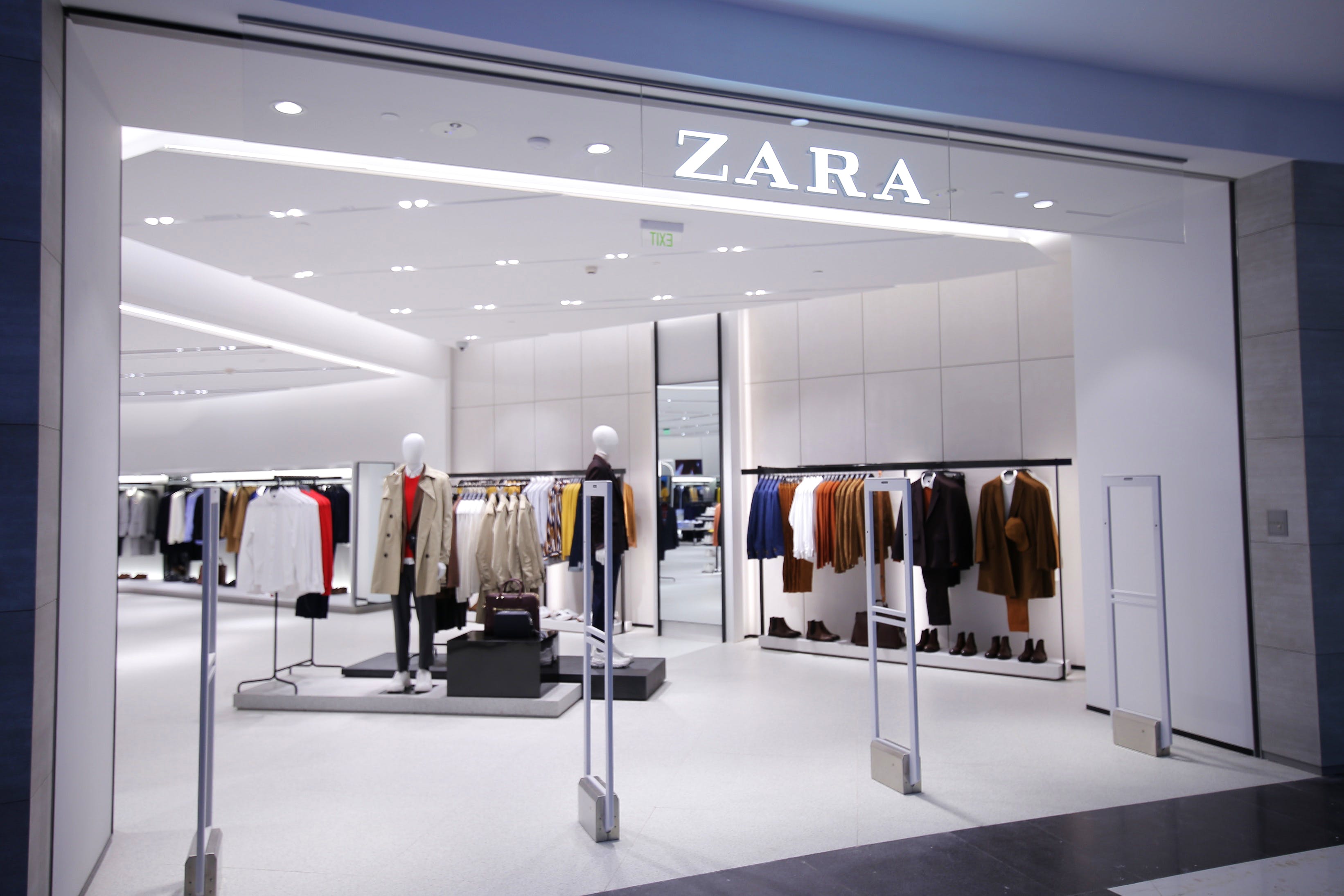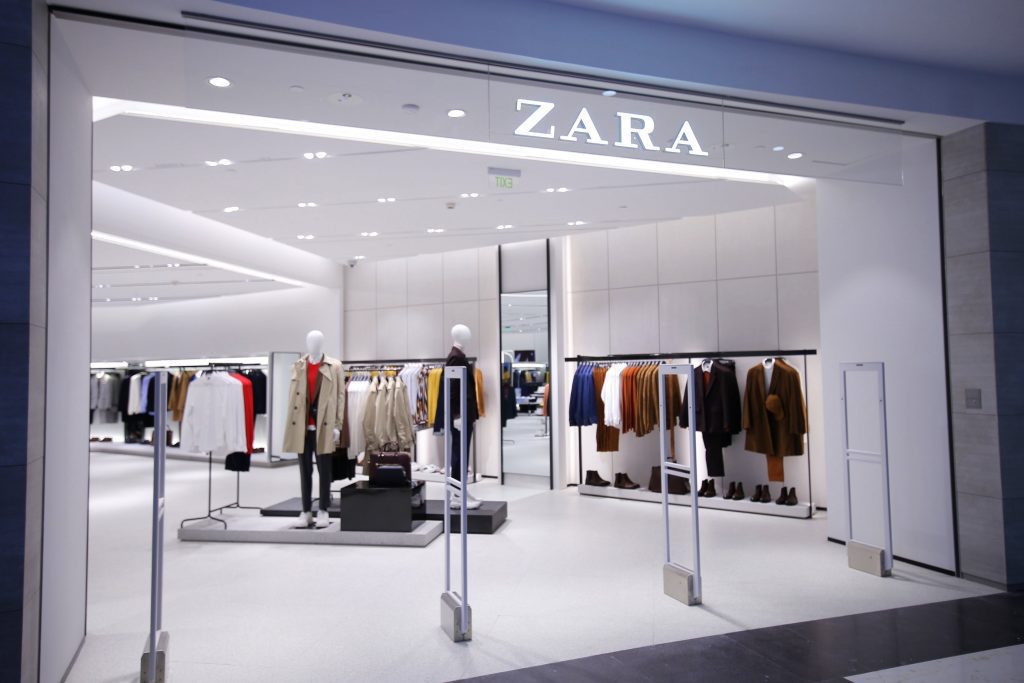While Hollister captures the California beach vibe, Zara leads with a runway-inspired aesthetic. So, how does a consumer decide which fashion brand is the best fit? Here, we explore the DNA of Hollister and Zara, comparing sustainability initiatives, market positioning, and global influence.

Hollister captures the California beach vibe
Hollister, a subsidiary of Abercrombie and Fitch Co., appeals primarily to teenagers and young adults with its California-inspired, laid-back aesthetic. Zara, on the other hand, is part of the Inditex Group and serves a broader audience with its fast-fashion approach.
Hollister and Zara offer trend-driven, affordable apparel and accessories. The two prominent brands in the fashion retail space, cater to different demographics and embody unique brand philosophies, making them distinct in both style and approach.
Popular for its quick turnaround from runway to retail, Zara delivers high-fashion, trend-responsive designs to a wide demographic, spanning from young adults to older consumers who seek affordable yet stylish clothing options.
In terms of business strategy, Zara emphasises speed and agility in design and production, enabling it to consistently refresh its collections and keep up with rapidly changing trends. This fast-fashion model has positioned Zara as a trendsetter, drawing shoppers who are interested in wearing the latest styles without delay. Hollister’s approach is on building a consistent brand identity rather than constantly shifting with trends.
While both brands have made strides in sustainability, their strategies differ: Zara is increasingly prioritising eco-friendly materials and sustainable practices within its high-volume production model, while Hollister’s initiatives centre on inclusivity and responsible sourcing aligned with its relaxed, youthful appeal.
Despite their differences, both brands have managed to cultivate loyal customer bases, each drawn to their distinct value propositions in the competitive retail landscape.
TABLE OF CONTENTS
- Hollister vs. Zara: Brand Philosophy
- Hollister vs. Zara: Sustainability Initiatives
- Hollister vs. Zara: approach to youth marketing in the digital age
- Hollister vs. Zara: Future Growth Strategies and Challenges
- Hollister vs. Zara: Collaborations
- Hollister vs. Zara: Global Reach and Market Penetration
- Hollister vs. Zara: Which Is the Best Brand for You
- How to Style Apparel and Accessories from Zara and Hollister
Hollister vs. Zara: Brand philosophy

Hollister’s brand philosophy embodies the Southern California lifestyle.
Hollister’s brand philosophy embodies the Southern California lifestyle, where a laid-back spirit and youthful energy are paramount. The brand aims to provide a welcoming escape for teenagers and young adults with collections that capture the essence of beach culture, sun-drenched days, and coastal freedom.
The casual, comfortable styles encourage individuality and self-expression through approachable, trend-aligned apparel. This ethos is designed to appeal to its youthful audience, fostering a sense of community and belonging by celebrating personal style and the relaxed Californian way of life.
Spanish fast fashion retailer Zara’s vision is to democratise fashion. Its vision involves a fast fashion strategy where products are produced at a high rate and distributed to customers at inexpensive prices. The brand gives customers what they want and gets it to them faster than anyone else by ensuring that the team identifies market preferences and has these products on the shop floor before their competitors.
This vision drives the brand to constantly evolve, ensuring it stays ahead of the latest trends and continues to meet the dynamic demands of the fashion industry, while maintaining its commitment to accessibility and inclusivity.
Hollister vs. Zara: Sustainability Initiatives
Both Hollister and Zara respond to consumer demand for sustainable practices, with Zara pushing for industry-leading goals and Hollister making incremental changes that reflect its focus on quality and durability.
Hollister partners with Textile Exchange to source materials in a responsible, transparent way. Abercrombie and Fitch achieved its goal of sourcing 100 per cent of its down from Responsible Down Standard certified sources since 2020; 29 percent of its cotton through Better Cotton in 2023; and 93 percent of units containing polyester fill was sourced as recycled polyester in fiscal year 2023.
Parent company Abercrombie and Fitch’s sustainability goals align with the UN’s Sustainable Development Goals. Per the website: ‘We’re advancing environmental initiatives in our internal practices by increasing education and awareness throughout our partnership base and through collaboration with the communities where we make and sell our products… we focus on GHG emissions, water and waste reduction in our operations and across the supply chain, and we strive to source more sustainable materials.’
As of January 2023, Abercrombie and Fitch energy supply is provided through a long-term renewable energy agreement, ensuring that the electricity used at its global headquarters and two New Albany, Ohio, distribution centres is offset with renewable energy credits.
To further address GHG emissions, A&F Co. is investing in smaller, omni-channel store formats tailored to local customer shopping preferences. It also continuously evaluates its store fleet, improving store productivity by remodelling, rightsizing, or relocating to smaller spaces and closing legacy stores.
Zara, on the other hand, is at the forefront of sustainable practices in fast fashion. Zara, in partnership with Circ—the fashion tech company that recycles textile waste back into new fibres—launched a womenswear line made with recycled textiles derived from polycotton textile waste.
“This first-of-its-kind collection demonstrates that innovation in new fibres and collaboration with specialised experts are two key pillars in advancing the circularity of the textile industry. Circ’s technology opens the door to effectively separate and recycle any blend of polyester and cotton, which is one of the most common textile blends in clothing. At Zara and Inditex, we want to lead the transformation of our industry by creating fashion collections rooted in circularity,” says Javier Losada, Inditex Chief Sustainability Officer.
“[We] are highly focused on making clothes in a responsible, sustainable way, that limits the impact on the environment and [which] challenges ourselves to continually work as hard as we can to improve how we manufacture,” daughter of Inditex founder Amancio Ortega and chair of Inditex Marta Ortega tells Vogue. “[We are] always looking for ways in which we can do better: working on new technologies, new ways to work with recycled materials, and helping create new fabrics that our designers, as well as others in the industry, can work with in the future. It’s the right thing to do, both morally and commercially, and it’s an approach that we’re absolutely committed to.”
Zara also pledges to be carbon neutral by 2040 and has set ambitious goals for water conservation and chemical management while parent company Inditex commits to sustainable paper packaging.
“Inditex has worked hard to keep endangered forests out of our textile supply chain,” Javier Losada, Inditex chief sustainability officer, said. “Now we will extend that work to our packaging, where we have already taken steps towards reduction, reuse and increase of recycled content.”
Hollister vs. Zara: Youth marketing in the digital age

Kate Moss X Zara
Hollister meets Gen Z where they spend time—social media. Recognising that its target market primarily uses platforms like TikTok and Instagram, Hollister has invested heavily in creating engaging, relatable content and launching interactive campaigns that encourage audience participation.
Hollister has collaborated with TikTok influencers like Charli and Dixie D’Amelio, who amplified Hollister’s message of authenticity and inclusivity while promoting specific collections. These influencers, with their massive Gen Z followings, brought immediate visibility to Hollister’s campaigns, increasing engagement and building a community of young, loyal followers.
Hollister also leveraged digital technology to make shopping interactive and personalised. For example, its Share2Give campaign on TikTok allowed users to post about Hollister while the fashion brand committed to charitable donations based on social shares, combining marketing with a socially responsible message. Hollister also launched the Social Tourist sub-brand, in partnership with the D’Amelio sisters, which uses a mix of digital-first fashion drops and limited releases to create exclusivity and excitement.
Zara, on the other hand, invests in technology to enhance operational efficiency and customer satisfaction. Innovations like RFID technology for inventory management and AI-powered analytics for trend forecasting exemplify Zara’s commitment to staying ahead in the digital landscape.
The Spanish retailer uses fast-fashion responsiveness and data-driven personalisation to engage young consumers. Known for its rapid trend adoption, Zara leverages data from social media and online shopping patterns to quickly identify and produce items that resonate with Gen Z. For example, Zara analyses trending topics on Instagram and TikTok to design pieces that reflect current aesthetics and fashion influences, ensuring that its collections feel relevant.
Zara’s strategy is less about influencer partnerships and more about creating a streamlined, trend-setting image that speaks directly to young consumers’ desire for immediacy and style relevance. To strengthen this appeal, Zara’s 6.2 million followers on Instagram and engaging posts reflect the brand’s minimalist aesthetic, showcasing new styles in a way that feels aspirational yet accessible.
Zara has also ventured into cutting-edge e-commerce experiences. The Zara app incorporates augmented reality features that allow users to visualise outfits on models and view items in 3D, helping shoppers make confident purchase decisions from home. The app also sends personalised style recommendations and restock alerts, which keeps young customers engaged and encourages repeat visits. The Spanish brand also offers the limited “drop” culture for its customers, where exclusive collections like the limited edition high-grade leather shoes are released online with a sense of urgency, appealing to Gen Z’s attraction to exclusivity and the thrill of limited-time offers.
Hollister vs. Zara: Future growth strategies

Zara operates on a scale that has made it one of the most globally recognized fast-fashion brands.
Hollister and Zara face unique challenges and opportunities shaped by their brand identities and customer bases. Hollister, part of Abercrombie and Fitch Co., is focusing on expanding its digital presence to attract its Gen Z demographic. A major growth area is their investment in omni-channel retail that combines online and in-store conveniences.
Hollister’s recent move toward smaller, experience-focused stores reflects its strategy to create immersive retail experiences that appeal to younger consumers, who value personalisation and engagement. A prime example would be when Hollister shut its flagship store in Soho and opened a smaller one in New York at 130 W 34th.
To address sustainability, Hollister is increasingly emphasising eco-friendly materials and production processes, aiming to capture the loyalty of young consumers who prioritise environmental responsibility.ent company Abercrombie & Fitch Co. is striving to source more sustainable fibres in key commodities, including cotton, polyester, down, wool and man made cellulosic fibre. However, the challenge lies in balancing these eco-initiatives with maintaining competitive pricing, as younger consumers also seek affordability.
Zara, as part of Inditex, approaches future growth with a focus on digital transformation and sustainability as well. Zara’s growth strategy involves ramping up its e-commerce operations and enhancing its tech-driven production and logistics systems to reduce lead time. Zara uses an automated marketing platform for sending relevant and timely emails notification to shoppers regarding everything from order status updates to back in stock notifications, and so on.
By leveraging data from online and physical stores, Zara anticipates trends and stocks quickly in response to customer preferences, ensuring a high turnover of fresh styles. The fashion brand also aims to achieve a fully sustainable model by sourcing 100 percent linen and polyester from preferent sources by 2025 in addition to 25 percent reduction of water consumption in their supply chain.
Per the official website: “We have ambitious sustainable targets for our key raw materials. Our move to innovative, organic or recycled raw materials is a key path to transform our industry, reduce our emissions and use clean energy and water… We are pioneering new types of recycled fibre, like Infinna™, to reduce waste and fund research into new recycling methods. We are also investing in start-ups such as CIRC, with its disruptive technology that will allow textile products made of polyester and cotton blends to be recycled on an industrial scale, one of the main challenges we face as an industry.”
Both, Hollister and Zara, face the challenge of navigating a competitive landscape marked by shifting consumer expectations and economic pressures. According to CNBC, Hollister is the fifth most appealing average-income brand to teens, perhaps due to the marketing strategies of Hollister and their focus on this specific segmentation of the market.
Zara, meanwhile, contends with criticisms of overproduction associated with fast fashion, prompting the brand to innovate in waste management and recycling efforts to stay relevant. Per Vogue business: ‘H&M, Zara, Uniqlo, Abercrombie and Fitch, Gap and Urban Outfitters are among the 30 brands now banned from Vestiaire Collective’s platform as part of its fast fashion crackdown…’
Hollister vs. Zara: Global reach and market penetration
Hollister, with its roots in the United States, primarily appeals to a teenage audience, which has shaped its expansion approach. Its presence is concentrated in North America, Europe, and parts of Asia, with a strong focus on markets where youth culture and American lifestyle branding resonate, such as the UK, Japan, and Germany.
Hollister’s global strategy centres on building immersive, California-inspired stores that highlight its laid-back, beach-themed aesthetic. However, the brand’s international growth has been selective and controlled compared to its competitors, often opting for few large stores in prime locations rather than widespread retail penetration, which allows it to retain a cohesive brand experience in each new market.
Zara, by contrast, operates on a scale that has made it one of the most globally recognized fast-fashion brands. With a presence in over 96 countries and thousands of stores worldwide, Zara’s approach to market penetration is defined by its fast-fashion model and high turnover of collections, appealing to a diverse demographic that spans age and style.
Zara’s global expansion strategy is also distinguished by its agile supply chain and technology-driven logistics, which enable it to adapt to customer preferences, maintaining its relevance in competitive markets, exemplified by the swift stocking of 500,000 pink scarves across 2,000 stores within days after customer requests. This agility is enabled by RFID technology, allowing Zara to track and restock items efficiently, reduce inventory costs, and fulfil orders quickly. This approach keeps Zara competitive, innovative, and closely aligned with customer needs.
Hollister vs. Zara: Choosing the best brand?

Hollister has a casual laidback vibe
Choosing between Hollister and Zara depends on what a consumer values most in a fashion brand and their personal style preferences.
For customers drawn to casual, comfortable clothing with a youthful edge, and resonate with an American beach lifestyle, Hollister offers affordable, relaxed styles that are perfect for those who prioritise comfort and simplicity in their wardrobe albeit with a touch of style.
On the other hand, Zara offers versatility and trend-conscious pieces that mirror runway looks for customers. With a spectrum of styles, Zara offers options for every occasion, from formal to casual, with an emphasis on staying ahead of fashion trends.
How to Style Apparel and Accessories from Zara and Hollister
- How can I style a classic Zara blazer for a casual look?
To create a casual look with a Zara blazer, pair it with high-waist jeans, a white tee, and ankle boots. Adding a crossbody bag or layered necklaces completes the effortless vibe.
- What’s the best way to wear a Hollister hoodie for a stylish, laid-back look?
For a laid-back yet stylish look, layer a Hollister hoodie over a plain tee and pair it with joggers or skinny jeans. Finish the look with casual sneakers and a beanie.
- How do I create a work-ready outfit with Zara’s trousers?
Pair Zara trousers with a fitted blouse or tucked-in knit sweater for a polished, work-ready outfit. Adding loafers or heels and minimalist jewellery will enhance the professional look, while a structured bag completes the ensemble.
- Can I style Hollister’s denim shorts for cooler weather?
Yes! Wear Hollister’s denim shorts with tights or leggings underneath, a cosy oversized sweater, and ankle boots. A scarf or beanie can add warmth, making this a versatile look.
- What accessories from Zara can elevate a simple outfit?
Zara offers a range of statement accessories. Try adding a bold necklace, structured handbag, or a wide-brimmed hat to a simple look. Zara’s chunky boots or sleek mules also add instant style to any outfit.
- How do I style a Hollister graphic tee for a trendy look?
Tuck a Hollister graphic tee into high-waist jeans or a denim skirt and add a belt to define the waist. Layer with a flannel or denim jacket, and finish the look with sneakers or combat boots for a trendy, youthful vibe.
- What’s the best way to dress up a Zara slip dress for an evening out?
To dress up a Zara slip dress, layer on a tailored blazer or leather jacket and add heels or ankle boots. A pair of bold earrings and a clutch will add sophistication to the outfit.
- Can Hollister’s flannel shirts be worn for more than casual outfits?
Definitely! To dress up a Hollister flannel, wear it tucked into a high-waisted skirt or tailored trousers, and add ankle boots.
- How can I incorporate Zara’s bold prints into my wardrobe?
To keep Zara’s bold prints balanced, pair a printed top or skirt with neutral basics in black, white, or beige. Alternatively, try layering a printed scarf or bag with a monochrome outfit for a subtle pop of colour and pattern.
- What are some ways to style Hollister’s denim jackets for different seasons?
For spring, wear a Hollister denim jacket over a sundress and sandals. In fall, layer it with a turtleneck and pair it with jeans for a denim-on-denim look, adding boots and a scarf.
Read More:
Jasmeen Dugal is Associate Editor at FashionABC, contributing her insights on fashion, technology, and sustainability. She brings with herself more than two decades of editorial experience, working for national newspapers and luxury magazines in India.
Jasmeen Dugal has worked with exchange4media as a senior writer contributing articles on the country’s advertising and marketing movements, and then with Condenast India as Net Editor where she helmed Vogue India’s official website in terms of design, layout and daily content. Besides this, she is also an entrepreneur running her own luxury portal, Explosivefashion, which highlights the latest in luxury fashion and hospitality.











